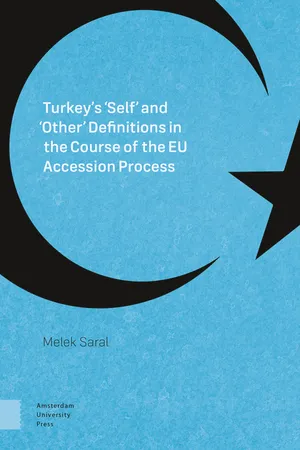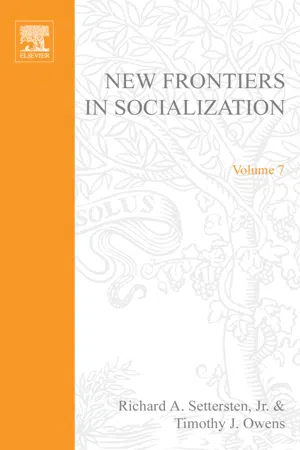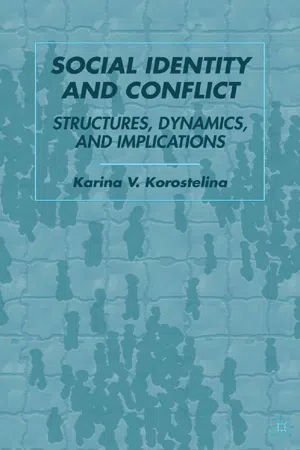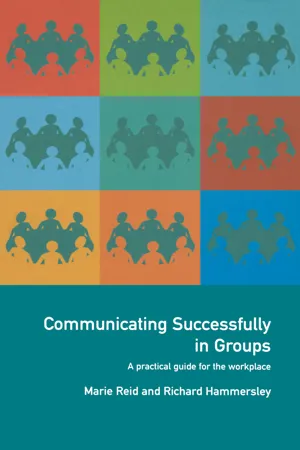Social Sciences
Socialisation and Identity
Socialization refers to the process through which individuals learn and internalize the values, norms, and behaviors of their society. It occurs through interactions with family, peers, media, and other social institutions. Identity, on the other hand, encompasses the characteristics and traits that define an individual, including their sense of self, belonging, and social roles, which are shaped by socialization experiences.
Written by Perlego with AI-assistance
Related key terms
1 of 5
10 Key excerpts on "Socialisation and Identity"
- Melek Saral(Author)
- 2017(Publication Date)
- Amsterdam University Press(Publisher)
2 The Concept of Socialization and Identity Change 2.1 The Concept of Socialization Socialization is a complex and ambiguous concept. The connection of socialization with a wide range of themes like national identity formation, change in interests, compliance with international norms, and the ef fects of international institutions put socialization and identity at the center of IR studies. There is a small but rapidly growing body of literature within the f ield of IR and in EU studies on socialization (Finnemore and Sikkink 1998; Risse et al. 1999b; Wendt 1999; Alderson 2001; Johnston 2001; Flockhart 2006; Schimmelfennig et al. 2006; Checkel 2005). Socialization is generally referred to as a process by which the newcomer becomes incorporated into organized patterns of interaction (Johnston 2001: 494). It is ‘the process of inducting actors into the norms and rules of a given community’ (Zürn and Checkel 2005: 1046). The process starts with an introduction to the new rules/norms/identities and proceeds through learning or ‘internalization’ (Schimmelfennig 2003; Johnston 2001; Risse 2000; Checkel 2005; Flockhart 2006). Throughout this process, institu-tional conditions and informal/formal rules structure social life while mechanisms such as instrumental bargaining, role playing, or persuasion shape which behavioral practices, norms of appropriateness, and outcome preferences are internalized by the political actors. The internalization of these practices, norms, and preferences are mostly regarded and analyzed on the individual level, as it is argued that they are internalized only by individual actors. However, the impact of these practices, norms, and prefer-ences are far-reaching. Socialization refers to both individuals and groups. The interactions among individuals also shape the group’s features.- eBook - PDF
Sociology
The Essentials
- Margaret Andersen, Margaret Andersen, Howard Taylor(Authors)
- 2019(Publication Date)
- Cengage Learning EMEA(Publisher)
Children learn through taking the role of significant others. Formation of self Identity is created through the interac- tion of mental and social worlds. Internalizing the values of society reinforces social consensus. Group consciousness is formed in the context of a system of inequality. Identity emerges as the creative self interacts with the social expectations of others. Influence of society Young children learn the principles that shape the external world. Society relies upon conformity to main- tain stability and social equilibrium. Social control agents exert pressure to conform. Expectations of oth- ers form the social context for learning social roles. Table 4-1 Theories of Socialization Social learning theory emphasizes how people model their behaviors and attitudes on those of others. Stephen Simpson/Taxi/Getty Images Copyright 2020 Cengage Learning. All Rights Reserved. May not be copied, scanned, or duplicated, in whole or in part. Due to electronic rights, some third party content may be suppressed from the eBook and/or eChapter(s). Editorial review has deemed that any suppressed content does not materially affect the overall learning experience. Cengage Learning reserves the right to remove additional content at any time if subsequent rights restrictions require it. CHAPTER 4 Socialization and the Life Course 90 about socialization would be most interested in how group identity is shaped by patterns of inequality in society. A person’s or group’s identity always emerges in a context, and if that context is one marked by different opportunities for different groups, then one’s identity will be shaped by that fact. This may help you understand why, for example, women are more likely to choose college majors in areas of study that have traditionally been associated with women’s traditional work opportunities. - eBook - PDF
- Richard A. Settersten Jr., Timothy J Owens(Authors)
- 2002(Publication Date)
- JAI Press(Publisher)
It designates the internalization of value-orientations, norms and symbolic meanings as well as the acquisition of social and practical skills by social learning and training. The focus on early life phases, however, was already questioned in the 1960s, when the Social Science Research Council established a “Committee on Socialization and Social Structure” that suggested to extend the concept to “Socialization after Childhood” (Brim & Wheeler, 1966). However, this initiative to consider socialization as a process across the life course, took quite a while to gain popularity among social scientists. There are also indications in developmental and social psychology that contribute to the insight that personality development must be understood as an ongoing process across the life span. There is the well-known model of E. H. Erikson (1982) which conceptualized identity development over eight stages from early childhood to old age, and, more recently, Baltes and associates (cf. Baltes, 1997) who elaborate the concept of life-span development. Another impulse to extend the socialization concept comes from attempts to link the social structure of the life course with the subjective interpretation of life experiences and life events. 41 1 11 1 11 1 11 1 11 Advances in Life Course Research, Volume 7, pages 41–64. Copyright © 2002 by Elsevier Science Ltd. All rights of reproduction in any form reserved. ISBN: 0-7623-0863-X Kohli (1988, 1991), for instance, suggests to combine the research on the institutionalization of the life course with the study of social meaning and personal experience which unfold in individual biographies. These developments not only extend the concept of socialization from childhood and youth to adulthood and even old age, they also indicate how to re-conceptualize the relationship between social structure, cultural norms and personal agency. - eBook - ePub
100 Years of Identity Crisis
Culture War Over Socialisation
- Frank Furedi(Author)
- 2021(Publication Date)
- De Gruyter(Publisher)
20 How to turn adolescents into adults was now frequently portrayed as a problem.Until the 1930s, the socialisation of the individual was rarely a specific focus of psychological or sociological study. It was ‘a relatively uncommon term in psychology before 1940’ but became ‘a social scientific hit after the war’.21 From the 1950s, socialisation became more and more a psychological concept and less and less connected to the workings of wider social trends. As one study noted, ‘although social scientists linked socialization to an array of institutions, they causally connected it, both directly and centrally, to then central psychological constructs of personality, adjustment, pathology, identity, and achievement’.22 In many scholarly discussions of this subject, socialisation appeared disconnected from its relation to the norms and values of culture. The traditional association of socialisation with connecting young people to their past was considered less and less to be a subject worthy of investigation.With the reconceptualisation of socialisation, the concept became increasingly individuated, internalised and psychologised. As principally a psychological phenomenon, the focus of interest turned towards its process rather than its social or moral content. Discussions of socialisation could not avoid referring to the transmission of norms and values altogether, but looking back on the evolution of the discussion one is struck by the relative absence of serious commentary on the content of socialisation. Yet, the issue at stake was not just the process of how adult society would socialise the young but also the norms and values to be transmitted to them. By the 1950s it appeared that many adults were not sure if they had any stories to transmit to the young. Writing in 1954, Arendt feared that many adults had given up their responsibility for socialising children.23 With the disruption of cultural continuity and a loss of the sense of the past, both the process but importantly the content - eBook - PDF
Social Identity and Conflict
Structures, Dynamics, and Implications
- K. Korostelina(Author)
- 2007(Publication Date)
- Palgrave Macmillan(Publisher)
By affording security and assurance, social identity deprives individuals not only of their freedom of choice but of their individuality as well, determining their behavior on the basis of group norms, goals, and beliefs. For the study of social sciences, social identity creates a conceptual bridge between individual and social levels of the analysis of social reality. Thus, social identity serves as a link between an individual’s psychology and the structures and processes of large social groups. As a result, the term “social identity” is now included in all fields of social science and has become an important part of numerous theoretical conceptions, from psychoanalytical theories to the models of nation building. The field of psychoanalytic studies focuses on the role of social identity in ethnic conflicts and cycles of violence 18 S o c i a l I d e n t i t y a n d C o n f l i c t (Volkan 1997, 2004). Anthropological research has shown the manifestation of social identity in culture, displaying its meaning and its impact on group boundaries (Barth 1969; Cohen 1986). Social psychologists analyze social identity in the process of intergroup relations, prejudice, and group conflicts (Tajfel and Turner 1986; Turner et al. 1987). Sociologists evaluate it to analyze the interrelations between personality and society (Giddens 1991; Jenkins 1996). Political scientists explore its role in domestic and interna- tional conflicts (Brubaker 1996; Fisher 1997; Gellner 1994; Gurr 1970). All these approaches analyze social identity as a dynamic construct that determines interrelations between individual behavior and social reality. Nevertheless, their understandings of the roots and mechanisms of social identity as a phenomenon vary, as do their methodological approaches and interpretations of results. - eBook - PDF
- Ian Craib(Author)
- 1998(Publication Date)
- SAGE Publications Ltd(Publisher)
1 INTRODUCTION: SOCIOLOGY AND IDENTI TY The fundamental identify ing feature of [the normotic personality] is a dis-inclinat ion to entertain the subjective element in life, whether it exists ins ide himself or in the other. The introspective capacity has been rarely used. Such a person appears genuinely naive if asked to comment on issues that require either looking into oneself or the other in any depth. Instead, if the evolution towards becoming a normotic personality is successful, he lives contentedly among material objects and phenomena. By the subjective element, I mean the internal play of affects and ideas that generates and authorizes our private imaginations, creatively informs our work and gives continuing resource to our interpersonal relations. (Bollas 1987: 137) Sociology seems to have a lot to say about identity. At the moment gender and ethnic ident ity seem to be at the forefront of the discipline's concerns while thirty years ago it was class ident ity (perhaps then more often referred to as class consciousness). There is much about the 'social construction' of identity and there is a range of associated terms: 'the self' (which I prefer since it seems to incorporate many of the others, including identity) subjectivity, the subject, subjectiv ities, the agent, agency and action all have something to do with ident ity, as does the simplest term in this catalogue -the ind ividual. Whenever I use the term 'identify ' in this book, I will be thinking of it as one element or process with in a self but I also want to add another term to the list, one which I would argue underlies them all: experience. Many of the chapters in this book point to the gap which is left in sociological understanding and explanation if we ignore experience. It seems to me, first, that any sociolog ical account of our world must imply something about the way people experience the world. - eBook - ePub
Communicating Successfully in Groups
A Practical Guide for the Workplace
- Richard Hammersley, Marie Reid(Authors)
- 2014(Publication Date)
- Routledge(Publisher)
6 The social construction of identityObjectives
By the end of this chapter you should understand the six basic ideas about identity that are listed below.Basic ideas about identity
We will draw upon both psychology and sociology and offer you six basic ideas:- Identity is fluid, dynamic and negotiable.
- Identity is communicative. We signify our social identities to other people, interpret feedback from them about what we are like and may modify our identities on the basis of that feedback.
- Our stable personal identities are constructed to make sense of what has happened to us and how we have related to other people.
- People’s identity constructs are usually socially functional for them, and this can apply even to deviant, damaged or spoiled identities.
- Identity involves identification with specific groups of people, but also contribution to the nature of those groups; this is a fundamental aspect of social activity.
- People routinely adopt different identities in different social groups; hence the idea of a social role.
The last two points will be covered in detail in other chapters. It follows from these key points that although you are often defined by your interactions with others, you can also change yourself and how others see you. Furthermore, this is easier to accomplish if you have good communication skills and awareness of how social processes work. To a certain extent it is possible to adjust your identity by managing how others perceive and judge you, although this does not mean that you should be manipulative about it. Indeed, people tend to disapprove of others who are overly concerned to present whatever identity seems the most socially convenient at the time.Identity is fluid, dynamic and negotiable
As we will see in Chapter 10 - eBook - PDF
- Dale Dannefer, Chris Phillipson, Dale Dannefer, Chris Phillipson, Author(Authors)
- 2010(Publication Date)
- SAGE Publications Ltd(Publisher)
Changes over time in how an individual thinks of him or herself, and how they are perceived by others, are said to reflect transformations in personal traits, characteristics, competencies, and social relation-ships. In the past decades, the influence of socio-economic status, policies, and other decisions in the public sphere, and social change more broadly conceived, have entered into discussions of life experiences and been recognized as causes chan-neling many aspects of identity and imputed changes accompanying age (Cockerham, 2005; Dittmann-Kohli, 2007; Hendricks, 2004). The goal of this chapter is to review some fun-damental tenets of investigations of self and social identity, to provide a more inclusive template link-ing self, identity, and social context, and to cast the elements in terms of life-course change and experiences affecting older actors. In so doing, the key literature will inform the discussion and, to the extent possible, issues of dynamic global changes early in the 21st century will be melded with dis-cussions of selfhood and social identity. As will be apparent, the similarity or dissimilarity of an actor to those around him and the affinity that actor feels with the social environment will not only affect experience but also the nature of the self (Rosenberg, 1986: 99). The self is inherently inten-tional, and is, therefore, the lens through which meaningfulness is created; it is a crucial compo-nent of psychological well-being. Whitbourne and Primus (1996) suggest self-concept is akin to a predicate, providing the schema by which the life-world is organized. One thing is certain, the self 252 THE SAGE HANDBOOK OF SOCIAL GERONTOLOGY emerges from social processes in a life-world that furnishes the social capital underlying shared understandings as well as the seeming stability of the life course (Dannefer, 1996; Hendricks, 1999, 2003). - eBook - ePub
- Klaus Hurrelmann, Ullrich Bauer(Authors)
- 2018(Publication Date)
- Routledge(Publisher)
CHAPTER 5 Socialisation in the individual life stagesThe explanations in the previous chapter show how much the individual stages of the life-course have shifted and changed in their extent and form over the past 100 years. Some of the challenges resulting from this restructuring of the life course for the biographic organisation and socialisation have already been mentioned. Today, a very open form of the life course is predominant, which enables a ‘chosen biography’ but also requires a demanding ‘biography management’. As has been shown, the implementation of such a biography management often fails today due to a lack of personal competences, but also due to persisting traditional, social, legal and institutional regulations stemming from the era of the alleged standard biography.This chapter will discuss the critical demands for the productive processing of internal and external reality in the individual life stages of childhood, adolescence, adulthood and seniorhood. Particular account is taken of the differences according to social background. It aims at identifying the structural problems occurring in coping with the developmental tasks to be mastered in the respective stages. This is done on the basis of the classification of developmental tasks in four groups described above: ‘Qualifying’ , the task of developing the competences necessary to cope with the social and performance requirements, as well as for later professional tasks; ‘bonding’ , the task of accepting the physical development and gender identity, and establishing partner relationships; ‘consumption’ , the task of developing the abilities required for dealing with the economic, leisure and media markets; and ‘participation’ , the task of developing a system of values and norms required to assert one’ s own interests and participate in shaping the community. - eBook - PDF
- David Block(Author)
- 2009(Publication Date)
- Continuum(Publisher)
Identities are about nego-tiating new subject positions at the crossroads of the past, present and future. Individuals are shaped by their sociohistories but they also shape their sociohistories as life goes on. The entire process is con-flictive as opposed to harmonious and individuals often feel ambiva-lent. There are unequal power relations to deal with, around the different capitals – economic, cultural and social – that both facilitate and constrain interactions with others in the different communities of practice with which individuals engage in their lifetimes. Finally, identities are related to different traditionally demographic categories such as ethnicity, race, nationality, migration, gender, social class and language. As I have made clear thus far, identity is a complex and multi-layered construct. It also is a construct that has tended to be examined from particular perspectives by theorists and researchers. In the sec-tions that follow, I examine what I consider to be the seven most common perspectives taken. I begin with a discussion of race and ethnicity together, as these two constructs are often conflated both in lay and academic discourses. I then consider, in separate sections, national identity, migrant identity, gender identity, social class iden-tity and language identity. Identity in the social sciences today 27 Ethnicity and race As May (2001) notes, most researchers who focus on ethnicity do not usually say what they mean by the term. In such cases, one is generally left to wonder if ethnicity is about culture, or if it is a polite way to talk about race. In the former case, ethnicity may be seen to be more about ‘common descent and . . . a cultural heritage shared because of com-mon descent’ (Joseph, 2004: 162). Elsewhere, Puri (2004) echoes Joseph’s cultural view of ethnicity as follows: Ethnicity is . . . a form of collective identity based on shared cul-tural beliefs and practices, such as language, history, descent, and religion.
Index pages curate the most relevant extracts from our library of academic textbooks. They’ve been created using an in-house natural language model (NLM), each adding context and meaning to key research topics.









